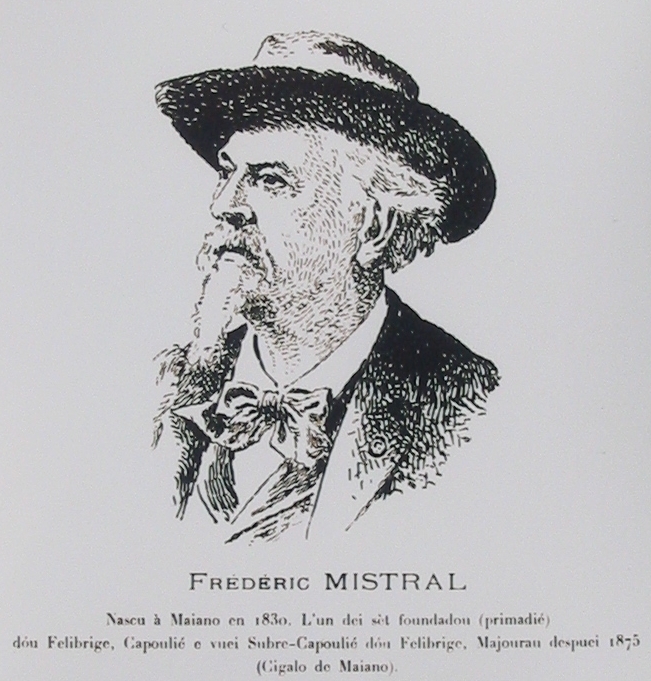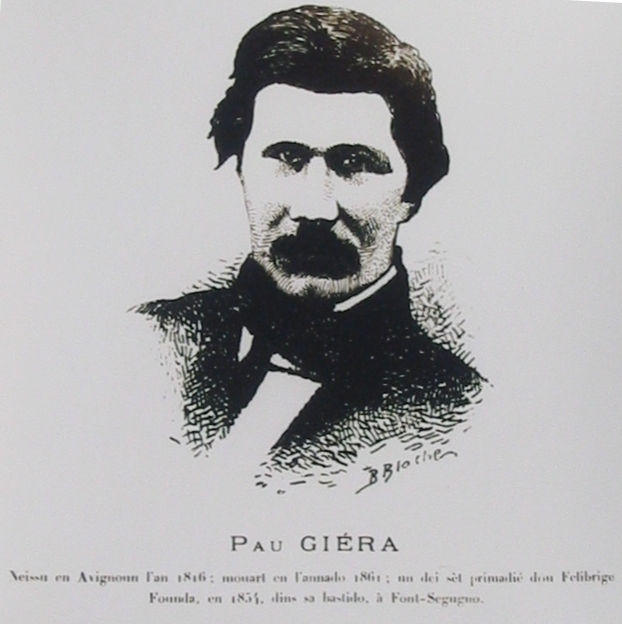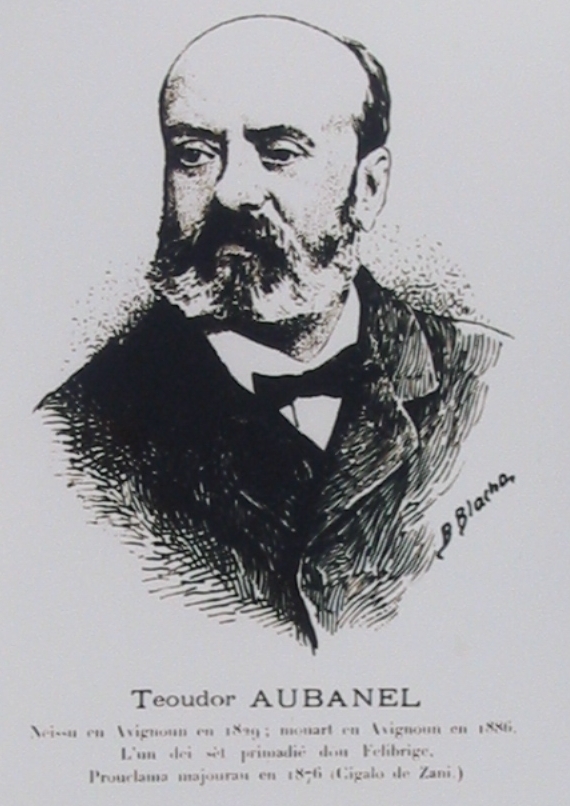 |
Le Chêne-Vert (The Green Oak): a century of legend
1876-1970
The history of the Chêne-Vert begins
in an auberge (inn) on the Right Bank of the Rhône in Les Angles,
around 1860. In his book, “Le Vieil Avignon” (Old Avignon), Henri
Bouvet describes Le Chêne-Vert as a place where people came to eat,
drink and dance. It had been run by the Abrieu family ever since 1809
and their ownership would continue until 1906. Spit roasts were the
speciality of the house.
The Chêne-Vert enjoyed a certain renown thanks to Mistral and his
friends: félibres (Provençal poets), painters, such as Antoine
Grivolas and fellow writers who liked to meet there to maintain
friendly and literary links. Mistral wrote: “It is at the
Abrieus’ that we can get away from the rest of the world and feast
ourselves at every literary occasion.” Their meetings were
frequently enlivened by talk of food and wine. Alphonse Daudet,
Stephane Mallarmé (at that time Professor of English in Avignon,)
were all part of the scene as well as a certain Nicolas de Séménov,
until then unknown in Provence. Séménov was so captivated by the
charm of the Chêne-Vert that he decided to stay there and thus
began, in Les Angles, the era of the Séménovs from 1867 to 1921.
Les SEMENOV: 1867-1921
In 1864, Frederick Mistral attended rehearsals
of “Mireille” in Paris. At the same time, a Russian
aristocrat published “La Dame du Monde” (The Lady of the World) a
novel about Italian manners and customs. The meeting of these two men
marked the beginning of an important event in the history of Les
Angles. Théodore Aubanel wrote: “ Nicolas de Séménov is a
Russian Lord, the most gentlemanly, the most French, the most
refined, the most enthusiastic person that I know…he is an
exquisite writer. He is also passionate about the Provençal language
and he loves Mistral like a brother.“ When Séménov visited the
Chêne-Vert he was completely captivated by the site and decided to
settle there. “He has just bought a plot of land and a part of the
grounds of the wonderful ‘Chêne-Vert’, which he adores, and this
winter he is going to build a charming, very comfortable, house with
terraces, galleries, something completely Italian…” wrote
Aubanel. In 1867, Antoine and Pierre Grivolas designed, constructed
and decorated the house in the Italian style. A literary circle was
created in the house around the félibres and their friends. All of
very different sensitivities: Paul Arène, Alphonse Daudet, Stephane
Mallarmé, Maurice Barrès, Prosper Mérimée. (Séménov was
planning to set ‘Colomba’ to music).
Even Victor Ballaguer, the outlawed
Catalan, who was to become a Member of Parliament in Cortès, took
part in these literary gatherings, as he was trying to establish
links between the Catalan Renaissance and the Provençal Renaissance.
(The origin of ‘La Coupo Santo’, the anthem of Félibrige.)
Many literary félibrées
are hosted by the
Séménovs at the Chêne-Vert: Théodore Aubanel speaks about one of
these such banquets: “…held in a room covered with garlands
of greenery and flowers, with inscriptions and Provençal coats of
arms. Anselme Mathieu read us some exquisite verses. The Spanish
outlaws were among the guests. They made splendid speeches in
terrible French. Marie de Séménov, in a gauze dress was our
hostess. She was more radiant than sun with her marvelous blonde hair
streaming over her shoulders and more gracious than a fairy.”
Madame de Séménov even inspired Alphonse Daudet for the character
of Sonia de Wassilief in “Tartarin sur les Alpes”. Mistral
devoted these famous lines of poetry to her: “O Countesso
gento
Estello dou Nord
Que la neu argento
Qu’Amour friso en
or
O fadeto saoro
Que lou regard beu
Comptrene que l’auro
Jogue
eme ti peu! “
On October 31st, 1886, Séménov died at Le Chêne-Vert
- the same day as Théodore Aubanel. His one single regret in
life was that he had never written in the Provençal language. In a
posthumous, unpublished collection, “Poésies du Chêne-Vert”
(1892), Mistral writes by way of a preface: “…in the middle of
the ivy which mourns him with you, and the rosemary and the viburnum,
and of the Spanish broom trees which he planted; in front of this
Florentine-Provençal landscape himself where one’s eye
embraces, in the distance, under the golden tower of Barbentane, the
confluence of the Durance with the Rhône, you see once again, alive,
your beloved poet, coming and going, talking to his friends the
Félibres. The signs are there, along the paths of Le
Chêne-Vert…
In 1870, Le Chêne-Vert became a care centre for wounded
men. (Ref the painting by Pierre Grivolas). When the house was
unoccupied it was open to the friends of Séménov, such as Paul
Mariéton. Heir apparent of Mistral, he was often invited to Le
Chêne-Vert and it was there that he found a last refuge in
1910. Mistral wrote:” Who would have thought that Paul Mariéton
would one day find himself in this sanctuary that is Le Chêne-Vert,
this pretty corner of Provence, infiltrated by the charms, joy and
dreams of the félibres of both the first and the second generation.”
In 1921, Marie de Séménov died in Russia without ever
again seeing her property in Les Angles, but having corresponded
regularly with her many Provençal friends.
Le Chêne-Vert is also linked to the
name of Bonaparte-Wyse. Marie de Chripounov, a niece of the
Séménovs, married André Bonaparte-Wyse, son of William
Bonaparte-Wyse. William Bonaparte-Wyse was born in Waterford,
Ireland in 1826 and died in Cannes in 1892. He was the grandson of
Lucien Bonaparte, cousin of Napoleon III. Bonaparte-Wyse was rapidly
introduced into the group of Félibres. On December 24th, 1859, he
met Mistral in Maillane. “He was a young Irishman who had travelled
all over the world, studied countries and various populations and he
distracted his melancholy with philosophy. He had read a lot,
wandered, seen.” Mistral. Paul Mariéton tells us that upon
entering Roumanille’s bookshop, Bonaparte-Wyse found books written
in an unknown idiom, he then imitated them and became a fervent
champion of the idea …” From May, 1867, he was to
give "Félibrées" of
three days duration, when each participant…” could put forward
their own ideas, argue their individual point of view, in convivial
company whilst partaking of a glass or two…” Thirty poets
attended these “félibrées”, the Catalans included. In 1875,
Bonaparte-Wyse struck up a friendship with Séménov and composed his
canticle of Sainte- Estelle, which was set to music by Séménov.
With the writing of "Parpaioun Blu" in 1868 and
of "Piado de la Princesso" in 1882, William
Bonaparte-Wyse marked his place in the Provençal history of
literature. Mistral said that this enlarged the wingspan of Félibrige
and that Bonaparte-Wyse had made it soar higher than his native
Alpilles. Bonaparte-Wyse’s sister, Mary de Solms, a lady of
letters, who lived between Aix-les-Bains, Italy and Spain, was
responsible for several magazines, one of which being the
“International” Magazine. She too contributed to this expansion
of félibrige and she counted Mistral and Armand de Pontmartin
amongst her contributors. She was to visit Le Chêne-Vert in March,
1894.
More recent history of Le Chêne-Vert
On the 29th
of October, 1945, André Bonaparte-Wyse, son of William, entrusted
the property to the city of Avignon for a duration of 25 years, so
that it could become an annex of the Palais du Roure, to welcome
notable guests: poets, artists, scholars and writers. The site was
classified on September 13th, 1950. Thanks to Jeanne de Flandrésy,
Le Chêne-Vert was to become a Mediterranean cultural centre. People
came to visit the property from all over the world. But in 1970, the
last page of history was finally turned.
“The nest of Le Chêne-Vert, now
empty of its singers and of its joie de vivre enters into the legend
books as a place where people stayed to enjoy its charm and its
poetry.” Mistral
Yasmine
Duriez
|







